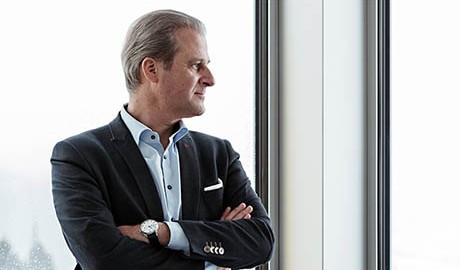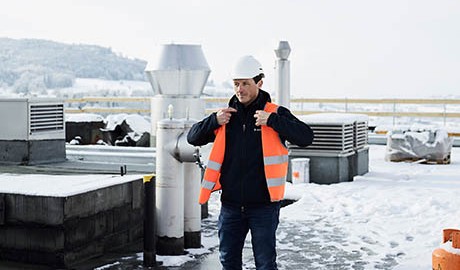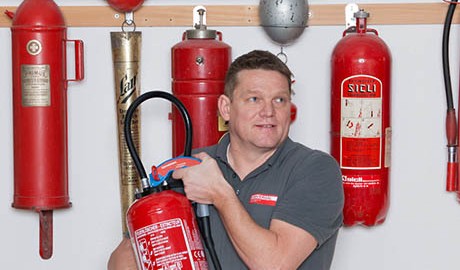Indoor climate monitoring
Using IoT to do away with stuffy air
Poor air quality affects performance. Heat inside the data centre threatens operational stability. Reinhard Bischoff, from Decentlab AG, offers a solution in the form of IoT-assisted climate sensors.
Text: Jörg Rothweiler, Images: Daniel Brühlmann,
Excessive CO2 levels, heat or humidity, as well as evaporation from production systems, paint on walls, floor coverings or textiles and – of course – people in a room can all create ‘stuffy air’ in many places. Odours, heat and humidity are noticeable, but increased CO2 levels or pollution from volatile organic compounds (VOCs) – released from evaporating solvents, paints, varnishes or plastics and sometimes even by plants (e.g. methane, isoprene, terpene) – usually go unnoticed. But these substances affect our well-being, mental performance and health, which is why the EU, for example, is currently discussing the possibility of introducing mandatory air quality monitoring in public buildings, such as schools or hospitals.
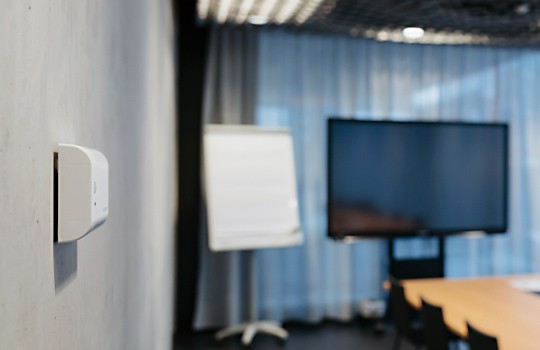
The indoor ambience monitor measures indoor carbon-dioxide concentration, temperature, humidity and barometric pressure.
The Internet of Things as a major driver of business
Reinhard Bischoff, Managing Director of Dübendorf-based Decentlab AG, shows how this might work in practice. The electrical engineer, who holds a degree from ETH, and his business partner, Jonas Meyer, develop sensors to monitor a whole range of parameters. The highlight: the measuring instruments are small, lightweight, decentralised, autonomous and – thanks to IoT technology – don’t need a power and internet connection. That’s because the data collected by the sensors is simply transmitted via Swisscom’s LoRaWAN-based low power network (LPN).
‘People who feel comfortable in their place of work show better long-term engagement and loyalty to their company. People breathing clean air while working do not get tired as quickly.’
Reinhard Bischoff
Reinhard Bischoff: ‘Ten years ago, Jonas and I were already working at the Swiss Federal Laboratories for Materials Science and Technology (Empa) in Dübendorf as part of an EU research project to develop a bridge-monitoring system that had to work autonomously. The project was a success and, subsequently, we founded the Empa spin-off Decentlab, in 2008. Today, we are a global provider of IoT sensor technologies.’
The company currently offers around two dozen sensor systems, devices and solutions for monitoring groundwater levels across large areas, measuring temperatures in the coldest places in Switzerland, recording growth of trees and plants in the Amazon and – as part of Switzerland’s CarboSense initiative – measuring CO2 concentrations in the air of cities, such as Zurich, Fribourg, Basel and Lucerne.
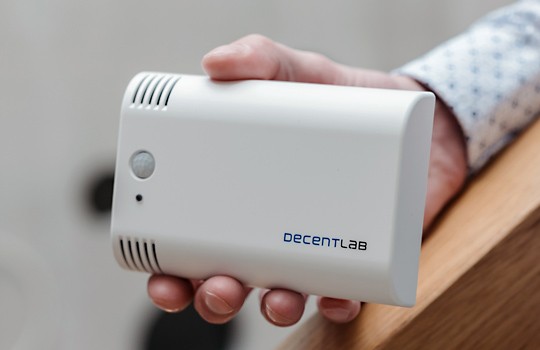
The sensors are small, lightweight and transmit the collected climate data via the Swisscom low power network (LPN).
New IoT system monitors indoor climate conditions
The latest project involves developing sensors to monitor air quality and climate conditions in closed rooms. The system, known as an indoor ambience monitor, measures the concentration of CO2 and VOCs, temperature, humidity and barometric pressure. It also measures light intensity, while pyroelectric infrared sensors (PIR motion sensors) detect the presence and movements of people. The data collected is transmitted via Swisscom’s LoRaWAN network, which is optimised for the Internet of Things, and analysed in real time. A piece of software then generates a visual representation of the data.
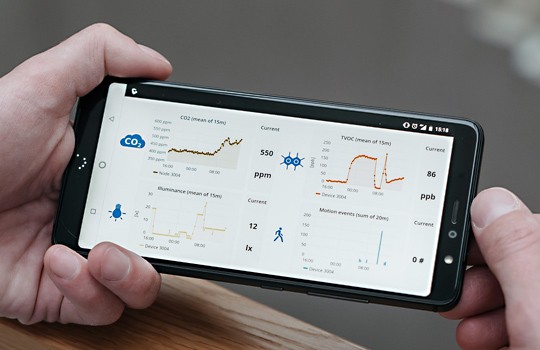
The app generates graphs of the collected data.
‘This ensures that our customers, which include companies, schools and universities, as well as data centres, shopping centres, airports, museums and other public institutions, always have up-to-date information about the air quality inside their buildings – and can respond proactively,’ explains Bischoff. The motion sensors allow the system to detect when people are entering a meeting room, for example. Ideally, lighting and ventilation can then be controlled automatically – before the air in the room becomes stuffy.
It is also possible to set up alarm triggers and alert the appropriate person via an app – for example, if there is a heat build-up in the data centre.
Bischoff is convinced that monitoring air quality and climate conditions offers customers so many benefits that the investment is worth it – even without the legal obligation being discussed in the EU: ‘People who feel comfortable in their place of work show better long-term engagement and loyalty to their company. People breathing clean air while working do not get tired as quickly. In addition, occupational safety is improved when people are focused and alert while operating machinery or production systems.’ The rest boils down to a simple cost-benefit calculation: when the productivity of all employees increases, newly purchased IoT systems for indoor climate monitoring quickly pay for themselves.

Reinhard Bischoff: ‘The sensors ensure that our customers always know about the air quality in their spaces – and can respond proactively.’
The IoT indoor ambience monitoring solution
- Active IoT solution for monitoring air quality and key parameters affecting comfort in closed rooms
- Easy to mount (adhesive strips), powered by two AA batteries
- Secure communication via Swisscom’s comprehensive LoRaWAN network and management via CMP LPN as part of a modular end-to-end enterprise IoT solution
- Measuring CO2, volatile organic compounds, temperature, humidity, barometric pressure, light intensity and motion
- Constant data transmission and analysis
- Web application with intuitive dashboard
Decentlab AG
- Founded: 2008
- Company size: 4 employees
- Structure: Public limited company (AG)
- Products: Sensors for outdoor and indoor use, including for measuring air quality, water levels, temperature, CO2 and other parameters
- www.decentlab.com
IoT ecosystems with Swisscom indoor connectivity
Networking devices inside buildings is no easy undertaking: thick walls, materials with shielding properties, such as concrete and steel, and areas deep underground impede the transmission of radio signals. While closed systems can help, devices made by other IoT providers are difficult to integrate into the network. Furthermore, it is not always possible to guarantee a direct external power line to the sensors, meaning that the devices need to have a long battery life.
New IoT access technologies, such as the LoRaWAN standard-based low power network (LPN) from Swisscom or the advanced Narrowband-IoT mobile communication standard, are ideal for data transmission inside buildings. They meet IoT-specific requirements, such as high network independence, high availability and security. The narrow bandwidth and large range enable reliable data transmission with low energy consumption – no matter where the sensors are located. Swisscom is implementing LPN and Narrowband-IoT for the national IoT expansion – and establishing a standard for countless new IoT ecosystems and digital applications.

Newsletter
Would you like to regularly receive interesting articles and whitepapers on current ICT topics?
More on the topic

